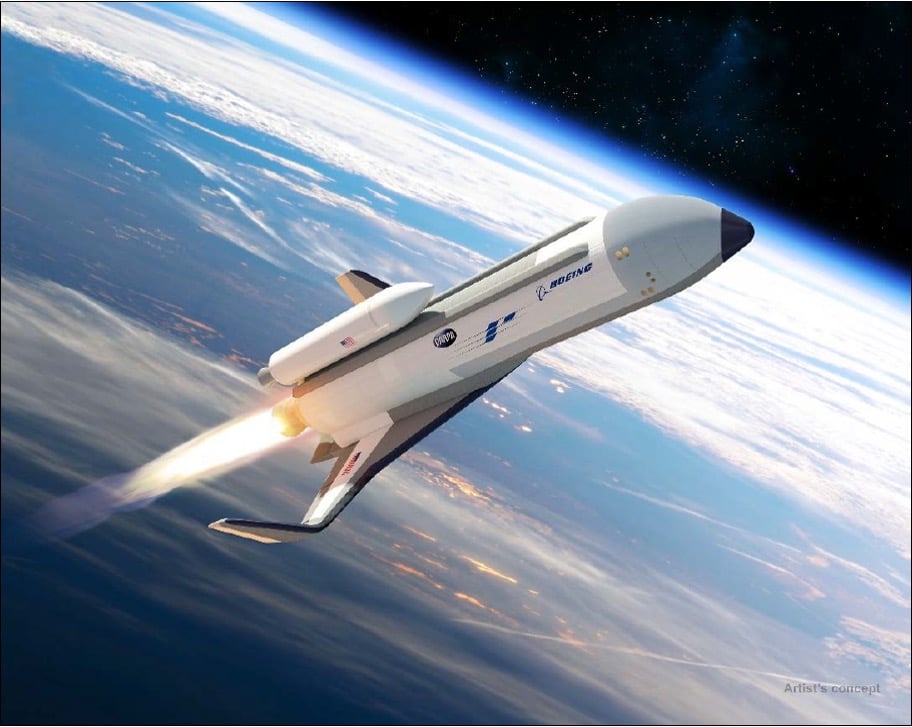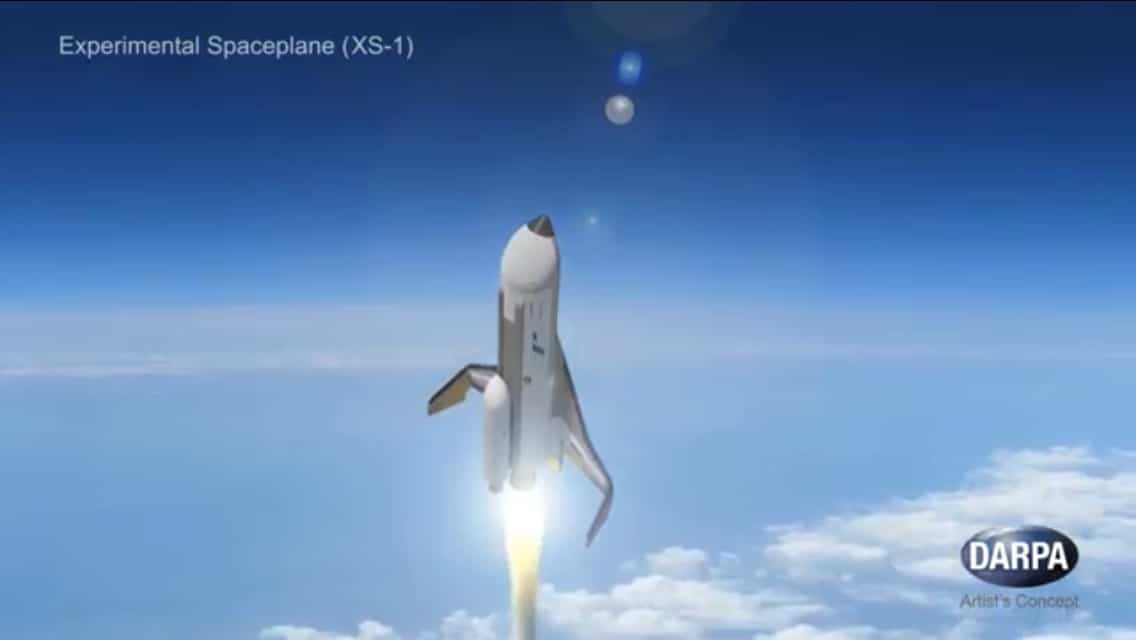Aviation
DARPA has selected The Boeing Company to build its Experimental Spaceplane (XS-1)

DARPA has selected The Boeing Company to complete advanced design work for the Agency’s Experimental Spaceplane (XS-1) program, which aims to build and fly the first of an entirely new class of hypersonic aircraft that would bolster national security by providing short-notice, low-cost access to space. The program aims to achieve a capability well out of reach today—launches to low Earth orbit in days, as compared to the months or years of preparation currently needed to get a single satellite on orbit. Success will depend upon significant advances in both technical capabilities and ground operations, but would revolutionize the Nation’s ability to recover from a catastrophic loss of military or commercial satellites, upon which the Nation today is critically dependent.
“The XS-1 would be neither a traditional airplane nor a conventional launch vehicle but rather a combination of the two, with the goal of lowering launch costs by a factor of ten and replacing today’s frustratingly long wait time with launch on demand,” said Jess Sponable, DARPA program manager. “We’re very pleased with Boeing’s progress on the XS-1 through Phase 1 of the program and look forward to continuing our close collaboration in this newly funded progression to Phases 2 and 3—fabrication and flight.”
The XS-1 program envisions a fully reusable unmanned vehicle, roughly the size of a business jet, which would take off vertically like a rocket and fly to hypersonic speeds. The vehicle would be launched with no external boosters, powered solely by self-contained cryogenic propellants.


Upon reaching a high suborbital altitude, the booster would release an expendable upper stage able to deploy a 3,000-pound satellite to polar orbit. The reusable first stage would then bank and return to Earth, landing horizontally like an aircraft, and be prepared for the next flight, potentially within hours.
In its pursuit of aircraft-like operability, reliability, and cost-efficiency, DARPA and Boeing are planning to conduct a flight test demonstration of XS-1 technology, flying 10 times in 10 days, with an additional final flight carrying the upper-stage payload delivery system. If successful, the program could help enable a commercial service in the future that could operate with recurring costs of as little as $5 million or less per launch, including the cost of an expendable upper stage, assuming a recurring flight rate of at least ten flights per year—a small fraction of the cost of launch systems the U.S. military currently uses for similarly sized payloads. (Note that goal is for actual cost, not commercial price, which would be determined in part by market forces.)
To achieve these goals, XS-1 designers plan to take advantage of technologies and support systems that have enhanced the reliability and fast turnaround of military aircraft. For example, easily accessible subsystem components configured as line replaceable units would be used wherever practical to enable quick maintenance and repairs.
The XS-1 Phase 2/3 design also intends to increase efficiencies by integrating numerous state-of-the-art technologies, including some previously developed by DARPA, NASA, and the U.S. Air Force. For example, the XS-1 technology demonstrator’s propulsion system is an Aerojet Rocketdyne AR-22 engine, a version of the legacy Space Shuttle main engine (SSME).
XS-1 Phase 2 includes design, construction, and testing of the technology demonstration vehicle through 2019. It calls for initially firing the vehicle’s engine on the ground 10 times in 10 days to demonstrate propulsion readiness for flight tests.
Phase 3 objectives include 12 to 15 flight tests, currently scheduled for 2020. After multiple shakedown flights to reduce risk, the XS-1 would aim to fly 10 times over 10 consecutive days, at first without payloads and at speeds as fast as Mach 5. Subsequent flights are planned to fly as fast as Mach 10, and deliver a demonstration payload between 900 pounds and 3,000 pounds into low Earth orbit.
Another goal of the program is to encourage the broader commercial launch sector to adopt useful XS-1 approaches, processes, and technologies that facilitate launch on demand and rapid turnaround—important military and commercial needs for the 21st century. Toward that goal, DARPA intends to release selected data from its Phase 2/3 tests and will provide to all interested commercial entities the relevant specs for potential payloads.
“We’re delighted to see this truly futuristic capability coming closer to reality,” said Brad Tousley, director of DARPA’s Tactical Technology Office (TTO), which oversees XS-1. “Demonstration of aircraft-like, on-demand, and routine access to space is important for meeting critical Defense Department needs and could help open the door to a range of next-generation commercial opportunities.”

Aviation
Boeing, Antonov to Collaborate on Defense Projects

– MOU represents Boeing’s commitment to work with Ukrainian industry
– Includes exploring opportunities for collaborating on in-country support of Unmanned Aerial Systems
A Memorandum of Understanding was signed today by Boeing and Antonov Company to investigate potential collaboration on defense-related projects.
“We’re happy to keep collaborating with the Antonov Company to help Ukraine’s economic development and expansion,” stated Ted Colbert, CEO and president of Boeing Defence, Space, & Security.
Airbus and the Antonov An-225: The Best Partnership:Click here
“This agreement demonstrates our ongoing efforts to find more opportunities to work with Ukrainian industry, which was underscored by our signing of the Ukrainian Defence Industry Compact earlier this year.”
The areas of potential collaboration identified in the agreement consist of training, logistical support and overhaul services for tactical Unmanned Aerial Systems utilized by the Ukrainian Armed Forces, which includes the ScanEagle. In addition, the companies will also explore opportunities for Antonov to provide engineering support to Boeing.
The six largest cargo aircraft ever built in the aviation industry:Click here
“A strong, innovative, and efficient defense industry is key to sustainable economic development and national security, and we are extremely excited to collaborate with Boeing,” said Ievhen Gavrylov, CEO of Antonov Company.
This agreement brings a whole new level of opportunity to implement the latest and most effective solutions – in addition to the possibility of future projects with Boeing in the aerospace and defense industry.”
-

 Travel1 week ago
Travel1 week agoAir India to Expand US Operations with Three New Routes After a Decade
-

 Travel2 weeks ago
Travel2 weeks agoWhy We Should Avoid These Stamps in a Passport
-

 Airlines1 month ago
Airlines1 month agoInvestigations Reveal Fake Chinese Titanium in Boeing and Airbus Jets
-

 Tech4 weeks ago
Tech4 weeks agoChina’s CATL Plans 1,800-Mile Electric Plane Launch by 2027
-

 Airport3 days ago
Airport3 days agoTop 10 Largest Airports in the World by Size
-

 Aerospace4 weeks ago
Aerospace4 weeks agoChina’s Fighter Jets Turn Wings into Autonomous Drones
-

 Airlines4 days ago
Airlines4 days agoAir India Rolls Out A350s for Delhi-New York JFK and Newark Routes
-

 Defence3 weeks ago
Defence3 weeks agoBoeing Enhances Chinook with New Engines and Block II Upgrades at $96 Million







